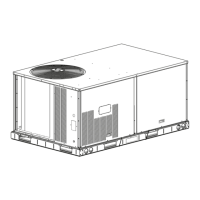29
ALARM STATE
The smoke detector enters the alarm state when the amount of
smoke particulate in the sensor’s sensing chamber exceeds the
alarm threshold value. (See Table 10.) Upon entering the alarm
state:
• The sensor’s Alarm LED and the controller’s Alarm LED
turn on.
• The contacts on the controller’s 2 auxiliary relays switch
positions.
• The contacts on the controller’s alarm initiation relay close.
• The controller’s remote alarm LED output is activated
(turned on).
• The controller’s high impedance multiple fan shutdown
control line is pulled to ground.
TROUBLE STATE
The SuperDuct
™1
duct smoke detector enters the trouble state un-
der the following conditions:
• A sensor’s cover is removed and 20 minutes pass before it
is properly secured.
• A sensor’s environmental compensation limit is reached
(100% dirty).
• A wiring fault between a sensor and the controller is
detected.
• An internal sensor fault is detected.
Upon entering the trouble state:
• The contacts on the controller’s supervisory relay switch
positions. (See Fig. 49.)
• If there is sensor trouble, then the sensor’s Trouble LED
and the controller’s Trouble LED turn on.
• If 100% dirty, then the sensor’s Dirty LED turns on and the
controller’s Trouble LED flashes continuously.
• If there is a wiring fault between a sensor and the control-
ler, then the controller’s Trouble LED turns on but not the
sensor’s.
Fig. 49 — Controller Assembly
NOTE: All troubles are latched by the duct smoke detector. The
trouble condition must be cleared and then the duct smoke detec-
tor must be reset in order to restore it to the normal state.
RESETTING ALARM AND TROUBLE CONDITION TRIPS
Manual reset is required to restore smoke detector systems to Nor-
mal operation. For installations using 2 sensors, the duct smoke
detector does not differentiate which sensor signals an alarm or
trouble condition. Check each sensor for Alarm or Trouble status
(indicated by LED). Clear the condition that has generated the trip
at this sensor. Then reset the sensor by pressing and holding the re-
set button (on the side) for 2 seconds. Verify that the sensor’s
Alarm and Trouble LEDs are now off. At the controller, clear its
Alarm or Trouble state by pressing and holding the manual reset
button (on the front cover) for 2 seconds. Verify that the control-
ler’s Alarm and Trouble LEDs are now off. Replace all panels.
Troubleshooting
CONTROLLER’S TROUBLE LED IS ON
1. Check the Trouble LED on each sensor connected to the
controller. If a sensor’s Trouble LED is on, determine the
cause and make the necessary repairs.
2. Check the wiring between the sensor and the controller. If
wiring is loose or missing, repair or replace as required.
CONTROLLER’S TROUBLE LED IS FLASHING
1. One or both of the sensors is 100% dirty.
2. Determine which Dirty LED is flashing then clean that sen-
sor assembly as described in the detector cleaning section.
SENSOR’S TROUBLE LED IS ON
1. Check the sensor’s Dirty LED. If it is flashing, the sensor
is dirty and must be cleaned.
2. Check the sensor’s cover. If it is loose or missing, secure
the cover to the sensor housing.
3. Replace sensor assembly.
SENSOR’S POWER LED IS OFF
1. Check the controller’s Power LED. If it is off, determine
why the controller does not have power and make the nec-
essary repairs.
2. Check the wiring between the sensor and the controller. If
wiring is loose or missing, repair or replace as required.
CONTROLLER’S POWER LED IS OFF
1. Make sure the circuit supplying power to the controller is
operational. If not, make sure JP2 and JP3 are set correctly
on the controller before applying power.
2. Verify that power is applied to the controller’s supply
input terminals. If power is not present, replace or repair
wiring as required.
REMOTE TEST/RESET STATION’S TROUBLE LED DOES
NOT FLASH WHEN PERFORMING A DIRTY TEST, BUT
THE CONTROLLER’S TROUBLE LED DOES
1. Verify that the remote test/station is wired as shown in
Fig. 47. Repair or replace loose or missing wiring.
2. Configure the sensor dirty test to activate the controller’s
supervision relay. See “Dirty Sensor Test” on page 27.
SENSOR’S TROUBLE LED IS ON, BUT THE
CONTROLLER’S TROUBLE LED IS OFF
Remove JP1 on the controller.
Table 10 — Detector Indicators
CONTROL OR
INDICATOR
DESCRIPTION
Magnetic Test/
Reset Switch
Resets the sensor when it is in the alarm or trouble
state. Activates or tests the sensor when it is in the
normal state.
Alarm LED Indicates the sensor is in the alarm state.
Trouble LED Indicates the sensor is in the trouble state.
Dirty LED
Indicates the amount of environmental
compensation used by the sensor (flashing
continuously = 100%).
Power LED Indicates the sensor is energized.
1. Third-party trademarks and logos are the property of their respective
owners.
Alarm
Power
Test/Reset
Switch
Trouble
RESET
ALARM
TROUBLE
POWER

